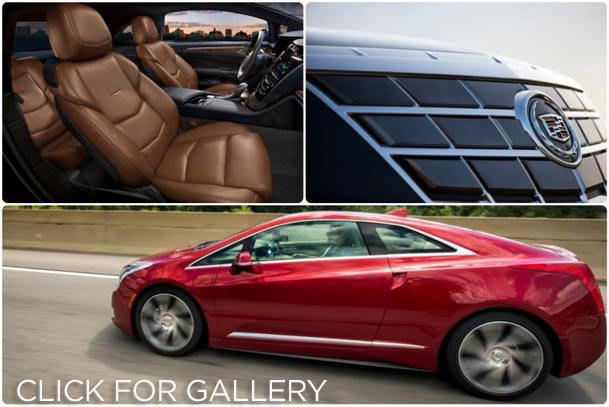
Pop music inevitably leaves older generations behind, but I find myself enjoying more of it lately through mashups, those unauthorized remixes that feature, say, Snow Patrol playing with Sting, or show that Taylor Swift's breakup lyrics fit perfectly within Weezer's breakup power chords. The best mashups feel like jigsaw puzzles of sound, with genius DJs finding the common edge between songs to craft a new whole without destroying what made the parts hits.
And it was only apt to make them the soundtrack of choice while driving the 2014 Cadillac ELR, a rolling mashup of electricity and gas, thrift and fashion, Motor City steel and Golden State dreams. The question was just how well Cadillac fit all of these notes into harmony — or dissonance.
Every auto show produces a few concept cars that look production-ready, and after a warm reception for the Converj show car in 2009 based off the Chevrolet Volt, General Motors brass ordered a street-ready version with the bare minimum of necessary alterations. (Designers kept the show car parked next to the mock-up in the studio.)
The Cadillac ELR not only improves on the Converj in exterior design, it arrives pre-loaded with history. It's the first electric-powered production car to wear a Cadillac badge, using the range-extending technology of the Chevy Volt. It gives Cadillac a model unlike any offered by its German or Japanese competitors. More significantly, the ELR will be the first model built by an established automaker directly in response to the Tesla Model S. Of the couple thousand ELRs Cadillac plans to sell every year, it hopes to land the majority among California's moneyed environmental elite who might otherwise give Elon Musk their stock options.

And here's where the ELR mashup first loses a beat. Tesla buyers have a fervency about their cars rarely seen among automakers, in part because Tesla owners often view themselves as champions for the environment, driving a car that demands (in theory) no compromises. Yet GM built the Volt and ELR as rolling compromises, for drivers who want electric-drive benefits, but at a lower cost, with the security blanket of a gas engine lurking underhood for long travels. Volt owners can match the fervency of Tesla buyers for loving their cars, but most often express their satisfaction in terms of gas gallons saved — a bragging point that inevitably weakens when the car costs $75,995 as the ELR does before $7,500 federal tax credits instead of $27,000.
To its credit, GM did not simply slap a coupe shape on a Volt chassis at the Detroit-Hamtramck plant. The major dimensions have been resized, the suspension reworked with adaptive struts up front and the battery pack with 1.4-liter gas engine/generator combo updated for more power; the 17.5-kWh battery takes about 4.5 hours to recharge with a 240-volt plug. For an $80,000 car, the ELR offers every luxury Cadillac designers can give a front-seat occupant, from the now-requisite Cue touch-screen system to hand-cut leather, suede and real wood around the interior. While the rear seats of the ELR have the same leather treatment, they might as well be hay bales for the amount of use they'll receive; my six-foot self simply couldn't fit due to the radically sloping roof.
Power figures — 217 hp total, and 295 lb-ft of torque combined — sound impressive for a small car, but the ELR suffers for its art and science luxury over the Volt, adding 300 lbs. to tip the scale with a two-ton curb weight. Tweaks to the Volt software mean the ELR can travel an average 37 miles on electric power alone, and perhaps longer if the driver switches the car into either "mountain" or "hold" mode. The dash to 60 in electric mode takes 8.8 seconds, the same time as the Volt, although if the gas engine has kicked in the ELR can shave a second off that time. Electric motors produce all of their power instantly, making the ELR feel sporty in slow traffic, but all that mass means there's simply not enough force to accelerate in impressive fashion for long.
Compared to the Volt, the ELR's upgraded chassis offers more aplomb, with less road noise, a better ride and more athletic steering. The low center of mass and 20-inch Bridgestone tires allow the ELR to get around corners well, but the power-to-weight balance and front-wheel-drive chassis means understeer will eventually damper anything too spirited.The ELR's major driving innovation comes from the paddles behind the steering wheel. With no gears to change, the ELR uses them for regenerative braking on demand. If you're coasting, a pull of the paddle slows the car to more aggressively recharge the battery (and engages the brake lights for safety). In pure EVs such as the Model S or BMW's new i3, regen braking automatically engages to extend range — and in the case of the BMW, has been dialed in so strong you rarely use the actual brake pedal in city driving. By making it optional, the ELR gives the driver a bit more control, and proved fun in bursts around the Malibu hills; for version 2.0, I'd make it stronger, and perhaps progressive rather than a simple on-off function.
During our drive, a few other testers brought up the last attempt by Cadillac to turn a Chevy into its lodestar — the late, unlamented XLR convertible, which took a Corvette and made it less powerful and worse looking. The ELR avoids all of the XLR's mistakes, and has far better components in most regards, and yet there's still an uncomfortable parallel that makes the Cadillac's biggest competitor in-house. Cadillac built its reputation on power, size and style; the ELR gambles that it has enough of the third to make up for the lack of the first two, along with a complicated green bonafide. It's a mashup that's unique, but not quite enough to make the ELR a big shot.


